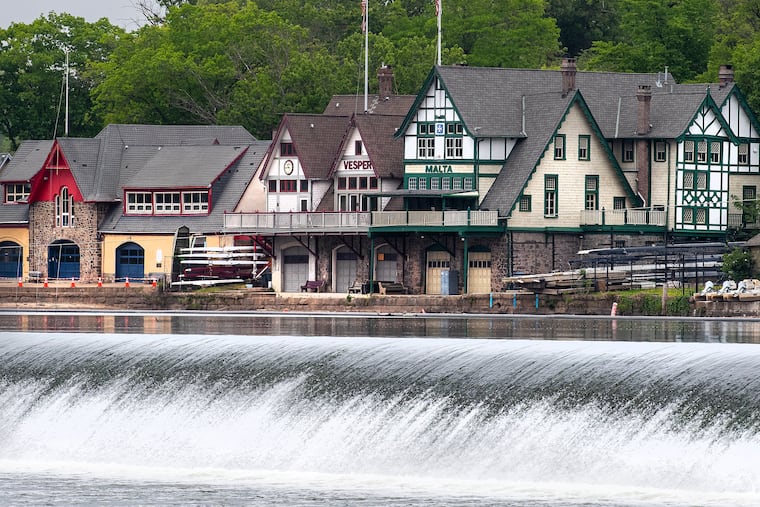Schuylkill dredging starts June 1 to clear sediment for rowers once fearful of regatta cancellations
A Bridgeton, N.J., company will begin dredging miles of the Schuylkill above Fairmount Dam to remove 60,000 cubic yards of sediment that was creating shallow lanes and hazards for rowers.

On June 1, a Bridgeton, N.J., company will begin dredging miles of the Schuylkill above Fairmount Dam to remove 60,000 cubic yards of sediment that has created hazards for rowers and threatened famed regattas that use the storied racecourse.
In preparation, the docks along Boathouse Row have been removed for the first time in a century.
The Schuylkill Navy, an association for amateur rowing clubs, had been racing to fund the dredge to avoid having regattas canceled because of sediment buildup. Though the effort began years ago, it ran into another block this spring with the coronavirus pandemic shutdown.
“We had so many challenges to mobilize for this job, eight years in the making, then came new challenges,” said Bonnie Mueller, vice commodore of the Schuylkill Navy. “It was a seemingly insurmountable task of pulling together the $4.5 million.”
The Schuylkill Navy announced in May 2019 that it had raised the funds from the city of Philadelphia, the state, local universities that have rowing clubs, the William Penn Foundation, and the rowing and paddling communities, as well as gifts from the public.
» READ MORE: Clogged with muck, shallow Schuylkill is putting rowing, regattas at risk
In December, the U.S. Army Corps of Engineers Philadelphia District, which is managing the project, awarded a contract to Atlantic Subsea Inc. to dredge portions of the non-tidal Schuylkill above Fairmount Dam.
Atlantic Subsea will dredge roughly three miles of the Schuylkill in stages including in front of Boathouse Row, a separate rowing lagoon, and the national racecourse farther upstream near the Strawberry Mansion Bridge. The sediment will be pumped via pipe to barges downstream, south of the I-676 bridge. The barges will then dispose of the dredged material at Fort Mifflin.
The dredging will start each weekday at 7 a.m. and is expected to last through the end of the year.
Mueller said coronavirus shutdowns issued by Gov. Tom Wolf on April 1 delayed the project for a few weeks as rowing clubs had to figure out a way to disassemble large docks from Boathouse Row while adhering to state orders.
Atlantic Subsea also had to suspend preparation work, such as laying pipe on the river floor to move the sediment. The project was eventually granted an exemption by Wolf.
All docks along Boathouse Row were removed by April, Mueller said. She noted that some clubs will use the removal as a way to either improve docks or replace them.
The dock removal gave organizers their first bird’s-eye view at how clogged the river had become, Mueller said.
“We saw overhead pictures of Boathouse Row when we took out the docks,” she said. “We were like, ‘Oh my gosh.’ The docks were breaking in places because the earth was pushing them up.”
A typical scull used by rowers is 14 inches deep, with about 10 inches sinking below the water. At some docks, sediment buildup was so severe that water got as shallow as 10 inches. That put regattas in jeopardy and was also causing hazards for more casual boaters.
The Schuylkill was last dredged in 1999, when 30,000 cubic yards of silt were removed over several months. Since then, silt has returned, layering on the bottom of the river and creating shallow waters in Lanes One and Six of the racecourse upstream from Boathouse Row. For fair competition, all lanes should be of equal depth, but some lanes were as low as 2-feet deep, while others ran 10-feet deep.
Though the course did not get to the point that it was declared unfair, rowers were fearful that regattas would be moved.
Regattas are a major economic driver for the city. The Jefferson Dad Vail Regatta, the largest collegiate regatta in the U.S., hosts more than 100 colleges and universities and draws thousands of athletes and fans. The Stotesbury Cup, the largest high school rowing regatta in the world, draws 6,000 athletes, and thousands of spectators.
Both events, usually held in May, were canceled and will return in 2021. All regattas through the summer have also been canceled.
If regattas are able to resume in the fall, Mueller said, her organization will be able to work around the dredging project.
“It was always the case that the regattas and rowing community were going to have to work around the dredging," Mueller said, “and not the dredging working around the rowing.”